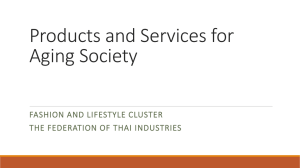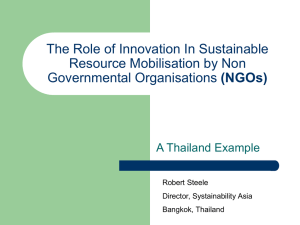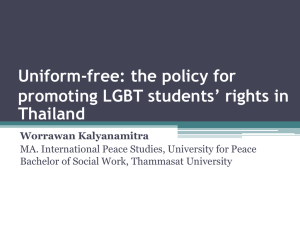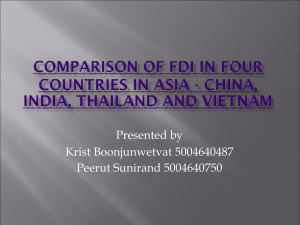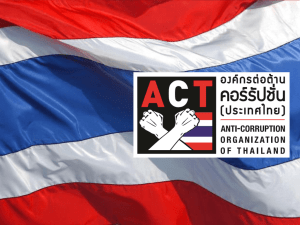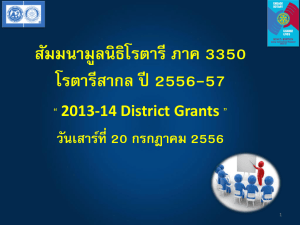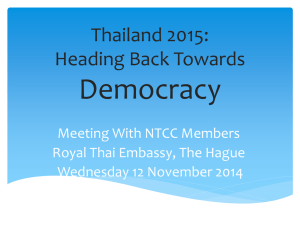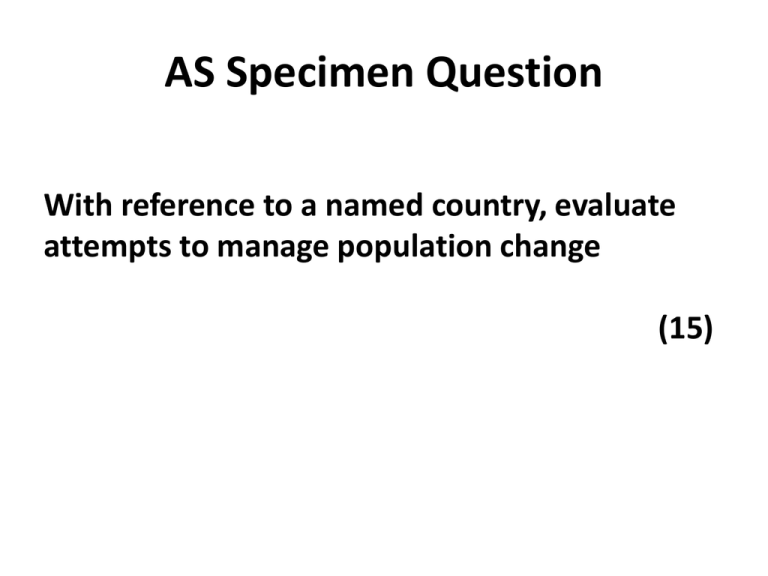
AS Specimen Question
With reference to a named country, evaluate
attempts to manage population change
(15)
Thailand: A Family Planning Success Story
1970
Growth Rate
Fertility
Contraception
use
Total population
GNP US $
3.2%
6.5
children/woman
≈ 15%
26.4 million
110
The success of the family planning programme
is attributed to a number of factors:
• Creativity of the family planning
approaches
• Openness of the Thai people to new ideas
• Willingness of the government to work
with the Population Development Agency
(PDA)
How did Thailand manage population change?
Much of the success is directly attributed to Mechai
Viravaidya, a former government economist and public
relations genius who launched the PDA.
How did Thailand manage to achieve
population change?
• Although condoms became the trademark of the
campaign, the Thai government supported Mechai’s
efforts by making a wide range of contraceptives
available to the public
• Thailand was amongst the first countries to use the
intravenous contraceptive DMPA and still remains one
of its largest users
• The contraceptive services were extended to even
remote rural areas
• Relationships between men and women are
considered to be more egalitarian than in
most of the developing world
• The prevalence of Buddhism (95% of Thais
are Buddhist) has supported the family
planning programme as the Buddhist
scripture preaches that ‘many children
make you poor’
• Non-scalpel vasectomies are available at festivals and
other events and the PDA offers free vasectomies on the
King’s birthday. Sterilisation has now become the most
widely used form of contraception in the country
Fusion of economic development with family
planning education
The PDA offers loans linked to contraception use. Loans were
based on character, credit worthiness and the type of project.
Interest rates were substantially lower than traditional
moneylenders in poor rural communities
• After the scheme became established, preference was given to
applicants who were practising family planning. Members of the
loan scheme received shares and dividends on the basis of the
contraceptive method used; the more effective methods had
higher values
• The PDA provided loans to build rain water catchment jars for
drinking water. They also set up rice banks, pig banks and buffalo
banks. No money was involved – just a loan in the form of the
animal
•
Thailand: A Family Planning Success Story
1970
1990
1999
Growth Rate
3.2%
1.4%
0.8%
Fertility
6.5
children/woman
2.2
children/woman
1.7
children/woman
Contraception use
≈ 15%
≈ 68%
≈72%
Total population
26.4 million
55.7 million *
66.6 million
GNP US $
110
1220
1950
* The population had expected to reach around 67 million by 1990 without any
family planning intervention. It was almost a decade later when the population
reached this point.
• The policy has received criticism for damaging
the tourist industry (worth US$ 4 billion
annually)
• Many critics feel that he has driven away
foreign tourists with his anti AIDS campaigns
and criticism of the commercial sex industry
• Mechai argues that he is trying to save the
tourist industry by controlling the spread of a
disease that would otherwise decimate the
population
AIDS in Thailand
• Prevalence rate is still very high at 1.4 %
• The last decade has seen a great political focus on the AIDS crisis
the budget increased 20 fold
a new massive public information campaign was launched under
the leadership of Mechai Viravaidya
the '100 percent condom programme' aimed to enforce
consistent condom use in all commercial sex establishments.
Establishments that failed to comply could be closed
1997 – prevalence rate was 2%
2003 – prevalence rate was 1.8%
2007 – prevalence rate was 1.4 %
Without these steps it is estimated that Thailand’s national prevalence
rate would be 10 times higher than it is.

